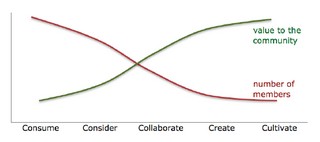
“Returning Champion” Lyzasoft made another visit to the BBBT. Unfortunately, due travel conflicts, I was unable to participate in person with the Lyzasoft team of:
- Scott Davis, CEO
- Brian Krasovec, CTO
- David Pinto, VP Engineering
Yet, I was fortunate enough to follow the #BBBT twitter feed remotely ( … as anyone can…  ) and I had a recent briefing from Scott Davis.
) and I had a recent briefing from Scott Davis.
Social Concepts
Lyzasoft brings to the table an interesting perspective. Not that BI needs to have social/collaborative elements “bolted” to it or that social/collaborative engines need to have BI “bolted to it…. But rather there needs to be a blend of these concepts.
In particular Lyzasoft brought the concept of the 5Cs of user roles:

This idea brings about a particularly valuable concept in that “maturity” ( …probably the wrong word, but good enough… ) of data/analytics creation-consumption roles within an organization.
Much like previous models associated with BI roles, this 5Cs of user roles takes into account the differences between consumers and creators of information. The key aspect that changes with this 5Cs model is that the collaboration is defined in “21st century” or “twitter-sphere” concepts rather than the cubie bullpen or meeting room table.
More Things Change More They Stay The Same
With this move toward a more collaborative philosophy; Lyzasoft, and their offerings Lyza and Lyza Commons, bring some of the tried and true aspects of business intelligence.
Of course you need to acquire and analyze the data… The key new addition is the “from the ground up” integration of social/collaboration aspects and having those aspects cascade back throughout the metadata ( … again probably not the ‘right’ word, but good for this conversation… ).

Linking the data lineage with the social aspects enables something that current social media and to a certain extent “old school” web applications have lacked. For many years, people asked about the validity of “Wikipedia” entries due to the lack of an ‘evidence’ trail associated with the information.
Now with Lyzasoft’s offerings it is possible to not only link datasets together and provide context “socially” and distribute “collaboratively”… AND… detail the history or lineage of the data.
Telecom Applications
Unfortunately, the culture of the average telecommunications organization will have many problems with the social/collaborative concepts behind Lyzasoft’s offerings. The idea of releasing centralized control may be too much for most telecom IT departments to understand/comprehend.
However once embraced/understood, telecom data governance professionals ( data stewards, etc ) will find the ability to spread data creation and consumption duties in a crowdsourcing manner ( … with associated “unproven” wikipedia reference… ) to be an excellent way to extend their reach into the business areas of the organization while providing additional value to their roles.
Specifically, I see great value to the ares of revenue and expense management within telecoms for Lyzasoft. These are two areas that often require a great deal of consensus and coordination between disparate groups. Being able to utilize social/collaboration concepts into the BI analysis will allow for the expansion of those who can contribute to these activities from core groups to those interested within the organization. Yet, there will be the controls and visibility to the data for IT stakeholders that will make the efforts meet some of the core data governance requirements and concerns.
In Conclusion
Lyzasoft is doing an excellent job of making both a conceptual and technical leap into social/collaborative BI. Rather than appending one concept to another, Lyzasoft is ( …in my opinion… ) growing an entirely new kind of BI application.